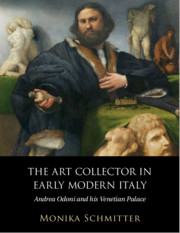
- Publisher:
- Cambridge University Press
- Online publication date:
- August 2021
- Print publication year:
- 2021
- Online ISBN:
- 9781108933315
- Subjects:
- Art, Western Art


Lorenzo Lotto's Portrait of Andrea Odoni is one of the most famous paintings of the Italian Renaissance. Son of an immigrant and a member of the non-noble citizen class, Odoni understood how the power of art could make a name for himself and his family in his adopted homeland. Far from emulating Venetian patricians, however, he set himself apart through the works he collected and the way he displayed them. In this book, Monika Schmitter imaginatively reconstructs Odoni's house – essentially a 'portrait' of Odoni through his surroundings and possessions. Schmitter's detailed analysis of Odoni's life and portrait reveals how sixteenth-century individuals drew on contemporary ideas about spirituality, history, and science to forge their own theories about the power of things and the agency of object. She shows how Lotto's painting served as a meta-commentary on the practice of collecting and on the ability of material things to transform the self.
‘Focusing on Lorenzo Lotto’s extraordinary Portrait of Andrea Odoni, this book is an engaging art historical detective story. The sitter, Andrea Odoni, is well known to Venetian specialists, largely from his portrait by Lotto and his appearance in the diary of Marcantonio Michiel, but the writer fleshes out this picture with new information yielded by enterprising archival and primary source research. She offers several overlapping portraits: of the Venetian cittadini as a caste, of Odoni himself, of his house and collection of art and antiquities, of the birth of collecting in Venice, and ultimately, of Lotto’s hermetic erudition and his extraordinary inventive skills in creating a portrait that is far more than a portrait.’
Patricia Fortini Brown - Professor Emeritus, Department of Art and Archaeology, Princeton University
‘Lucidly written and meticulously documented, The Art Collector in Early Modern Italy reveals how a case study of an individual can open up new ways of thinking about immigration and social class, the imbrication between objects and the self, and the architectural presence of a home museum in urban space. Monika Schmitter offers us a compelling account of Venetian art and society which will be read, discussed, and enjoyed by a new generation of scholars.’
David Kim - Associate Professor of Art History, University of Pennsylvania
'This brilliant book takes us deep into the world of sixteenth-century Venice through the figure of Andrea Odoni, tax collector turned art collector. Marshalling period sources, works of art, and a range of interdisciplinary approaches, Monika Schmitter delves into Odoni’s milieu and what made him tick. This persuasive study explores the ways in which Odoni’s house and collections were typical of his social class and his time – and the ways in which they were exceptional. Odoni’s Venice offers precedents for many of today's notions about collecting, museums, art conservation, and the role of culture to define our identities.'
Frederick Ilchman - chair of the Art of Europe at the Museum of Fine Arts, Boston, and chairman of Save Venice
‘This excellent book … marks an impressive advance in our understanding of Lotto’s portrait, largely because it also provides an unpredecentedly detailed an thoughtful analysis of the sitter, his house and his collection. Along the way these aspects of [Odoni’s] personality and self-expression are illuminatingly integrated within a wider consideration of his social position and of the design and decoration of Venetian palaces in the first half of the sixteenth century as well as of strategies of display.'
Peter Humfrey Source: Burlington Magazine
‘Rich in primary sources and well-illustrated, Schmitter’s study … is invaluable in its coverage of the uniqueness of the surviving records and works: it provides a whole picture of a collector, the architectural spaces of his palace, and the range of materials and works on display.’
Leah R. Clark Source: Journal of the History of Collections
 Loading metrics...
Loading metrics...
* Views captured on Cambridge Core between #date#. This data will be updated every 24 hours.
Usage data cannot currently be displayed.